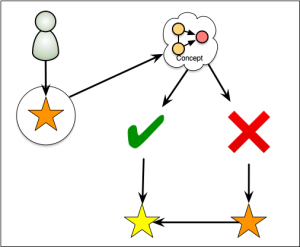I’ve wrestled with the concept of feedback for a while. I think Valerie Shute’s summary she did for the ETS is superb, BTW. And, of course, I select a pragmatic subset for the purposes of communicating the essential elements. However, it’s always been a list of important items. Which isn’t how I want to do it in a webinar. I was thinking about it today, and I began to get an idea. So, I started diagramming feedback.
 What are the essential elements of feedback? Well, it should be on the performance, not the individual. It should be model-based, in that you should be using models to explain how to perform, showing examples of the model being used in context, and then asking the learner to use them. The feedback, then, uses the model to explain why what went right, or what went wrong. Also, it should be minimal other than that.
What are the essential elements of feedback? Well, it should be on the performance, not the individual. It should be model-based, in that you should be using models to explain how to perform, showing examples of the model being used in context, and then asking the learner to use them. The feedback, then, uses the model to explain why what went right, or what went wrong. Also, it should be minimal other than that.
So, here I tried to show that the individual (or group, hmm) produces output. That output is evaluated by the model to ascertain correctness, or not. (Not the individual!) If the answer’s wrong, you say why, and then the right answer. If it’s right, you just reinforce the right answer.
Of course, this representation doesn’t convey the minimal aspect. It’s also not clear about using the model in the feedback. Still, so far it’s a representation I can talk to. So, this is my first stab at diagramming feedback. I welcome same!
Hattie and Temperley have been my guides since discovering their model via 3 Star Learning
https://3starlearningexperiences.wordpress.com/tag/effective-feedback/